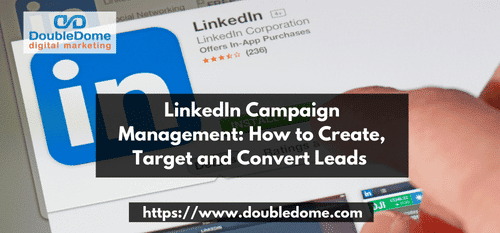LinkedIn is a powerful tool for small business owners. When used correctly, LinkedIn can be an effective way to generate leads and convert those leads into customers. In this blog post, we will discuss how to create, target, and convert leads using LinkedIn campaign management.
How to Create a LinkedIn Campaign
The first step in creating a LinkedIn campaign is to determine your objectives. What do you want to achieve with your campaign? Once you know your objectives, you can create targeted content that will speak to your audience and help you achieve your goals.

When creating your content, it is important to keep your target audience in mind. Who are you trying to reach with your campaign? What type of content will appeal to them? Once you have answered these questions, you can begin creating your content.
When creating your content, it is also important to consider the different stages of the buyer’s journey. The buyer’s journey consists of three stages: awareness, consideration, and decision. You should create content that speaks to each stage of the buyer’s journey. For example, if you are targeting someone in the awareness stage, your content should be educational and informative. If you are targeting someone in the consideration stage, your content should be more persuasive and highlight the features and benefits of your product or service. And finally, if you are targeting someone in the decision stage, your content should be focused on helping the customer make a decision and take action.
Once you have created your content, it is time to start promoting it. There are a number of ways to promote your content on LinkedIn. You can use organic methods such as posting on LinkedIn groups or writing articles on LinkedIn Pulse. You can also use paid methods such as Sponsored Updates or LinkedIn Ads.
How to Target Your LinkedIn Campaign
When targeting your LinkedIn campaign, there are a number of factors to consider. First, you need to identify your target audience. Who do you want to reach with your campaign? Once you know who your target audience is, you can start thinking about where they are in the buyer’s journey. Are they aware of their problem? Are they considering solutions? Or have they already made a decision? Knowing where they are in the buyer’s journey will help you determine what type of content to create (we discussed this in more detail above).
In addition to identifying your target audience and understanding their position in the buyer’s journey, you also need to consider other factors such as location, job title, company size, and so on. All of these factors will help you narrow down your targeting so that you can reach the right people with your message.
Converting Leads Into Customers
Once you have created targeted content and promoted it effectively, you should start seeing some results in the form of leads. But generating leads is only half the battle; the next step is converting those leads into customers.
There are a number of ways to convert leads into customers on LinkedIn. One way is by sending personal messages to each lead. When sending messages, be sure to personalize each one so that it doesn’t feel like a generic form letter.
Another way to convert leads into customers is by using InMail ads. InMail ads allow you to send messages directly to people who are not connected with you on LinkedIn. In order for InMail ads to be effective, however, they must be well-written and relevant to the recipient; otherwise, they will likely be ignored altogether.
The final way to convert leads into customers is by using lead forms. Lead forms are forms that appear on specific pages on LinkedIn (for example your company page or a sponsored update). Lead forms allow visitors to submit their contact information directly on LinkedIn without having to leave the site; this makes them more likely to convert into a customer than if they had to visit another site (such as your website)to fill out a form there.
Conclusion
If used correctly, LinkedIn can be an effective tool for generating leads and converting those leads to customers. There are a number of different ways to use LinkedIn for campaign management, including organic methods, paid methods, and lead forms. Each method has its own advantages and disadvantages, so it’s important to understand which one will work best for you and your business before getting started. A well-executed LinkedIn campaign can help you reach your target audience, engage with them, and convert them into paying customers.








